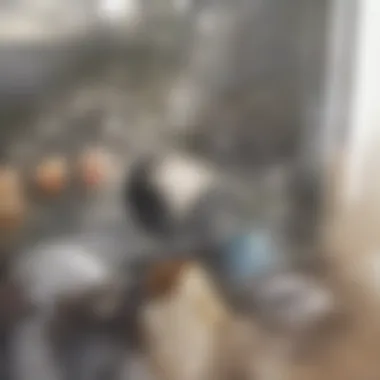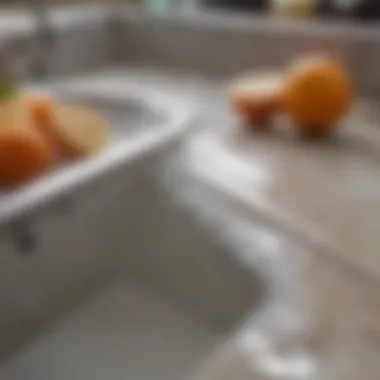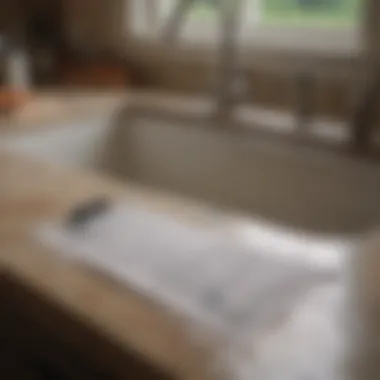Effective Strategies to Clear a Clogged Kitchen Drain


Intro
A clogged kitchen drain can pose significant challenges to homeowners. The inconvenience disrupts daily chores like washing dishes, and can even create unpleasant odors that linger in the air. Understanding how to effectively manage and prevent such issues is essential for maintaining a functional and inviting kitchen space. This article will explore various strategies to identify causes of clogs, methods to clear them, and preventive measures to ensure drains remain clear. By equipping readers with the right knowledge and techniques, they can maintain an optimal plumbing system.
Understanding Clogged Drains
Clogs can arise from several factors. Food particles, grease, and soap residues are common contributors. When these materials accumulate, they can create blockages that hinder water flow. Over time, buildup restricts drainage and may lead to deeper plumbing issues. Recognizing these causes is crucial for addressing clogs efficiently. A proactive approach can save time and prevent costly repairs.
"The key to maintaining a clean kitchen drain is understanding what can cause blockage in the first place."
Effective Clearing Techniques
Several methods exist to tackle a clogged kitchen drain. Each technique has its own strengths. Here are a few effective strategies:
- Boiling Water: Pouring boiling water down the drain can help dissolve grease and soap buildup. Ideally, this should be done periodically as a preventive measure.
- Baking Soda and Vinegar: This combination creates a chemical reaction that can break down minor clogs. Pour half a cup of baking soda down the drain followed by a cup of vinegar. Wait for a few minutes and then flush with hot water.
- Plunger: Using a plunger effectively dislodges stubborn clogs. Ensure there is enough water in the sink to cover the plunger's cup. This creates an effective seal, allowing for better suction.
- Drain Snake: If clogs persist, a drain snake can be an indispensable tool. This device reaches deep into pipes to remove blockages that are otherwise inaccessible.
- Chemical Drain Cleaners: As a last resort, chemical cleaners can help. However, they should be used sparingly due to potential damage to pipes over time.
Preventive Measures
Once the drain is cleared, preventing future clogs is essential. Regular maintenance can significantly reduce the chances of blockages. Consider the following actions:
- Avoid pouring grease down the drain. Use a container for fats and oils instead.
- Use a drain catcher. This simple tool catches food particles and prevents them from entering the plumbing system.
- Regularly flush drains with hot water. This practice keeps accumulations at bay and maintains overall cleanliness.
Finale
Addressing a clogged kitchen drain involves understanding its causes and employing effective clearing techniques. By following preventive measures, homeowners can maintain a smooth-functioning plumbing system. Investing time in these strategies ensures a fresher kitchen environment free from unpleasant odors and disruptions.
Preamble to Kitchen Drain Clogs
In the realm of household maintenance, kitchen drain clogs present a significant challenge. Addressing these issues promptly not only preserves the function of your kitchen but also reduces the risk of more severe plumbing problems. An efficient kitchen drain prevents unpleasant odors, water buildup, and potential water damage.
Understanding the Importance of a Functional Drain
A functional kitchen drain is crucial for the overall hygiene and efficiency of any home. Without proper drainage, food particles and liquids accumulate, leading to clogs. These clogs create an environment conducive to bacteria and foul smells. Additionally, a blocked drain can disrupt daily routines, making simple tasks like washing dishes become daunting. Homeowners should recognize that maintaining clear drains is as fundamental as routine cleaning practices and can save significant time and money in the long run. Regular attention to drain health contributes to a smoother, more effective kitchen experience.
Common Signs of a Clogged Kitchen Drain
Identifying a clogged kitchen drain early can mitigate more significant issues down the line. Here are some common signs:
- Slow drainage: Water taking longer than usual to drain can be the first indicating factor.
- Unpleasant odors: A lingering smell in or around the sink usually signals trapped food particle buildup.
- Gurgling sounds: If a gurgling noise is heard when water is draining, air is likely trapped in the pipes.
- Overflow: Water coming back up into the sink is a clear sign of a blockage.
Recognizing these symptoms early can help maintain the integrity of kitchen plumbing and avoid the hassle of emergency repairs.
Causes of Clogged Kitchen Drains


Understanding the causes of clogged kitchen drains is essential for homeowners. When these drains become blocked, it can lead to a host of problems including unpleasant odors, slow drainage, and even damage to plumbing systems. Identifying the underlying reasons for clogs allows individuals to take proactive measures to prevent them from recurring. By addressing these specific causes, one can effectively maintain the functionality of their kitchen, ensuring a better living environment.
Accumulation of Food Particles
One of the primary causes of clogged kitchen drains is the accumulation of food particles. This often happens when food scraps are improperly disposed of down the sink, especially those that do not break down easily such as starchy items or fibrous vegetables. As food particles collect in the pipes, they can combine with grease and soap, creating a substantial blockage over time. Regular cleaning can help mitigate this issue. Homeowners should consider using a disposal unit or a strainer for food waste, which significantly reduces the chances of particles entering the drain.
Grease Buildup Over Time
Grease buildup is another significant contributor to kitchen drain clogs. When cooking, oils and fats often end up in the sink. These substances can solidify as they cool, forming thick deposits on the inner walls of pipes. This buildup narrows the passage through which water flows, leading to drainage issues. It is advisable to dispose of cooking grease and oil in a container rather than pouring it down the drain. Additionally, introducing hot water into the drain regularly can help keep grease in a liquid state, thus preventing accumulation.
Foreign Objects in the Drain
Foreign objects are frequently responsible for sudden clogs. Items such as utensils, bottle caps, or small toys can accidentally fall into the sink. These blockages can be particularly problematic as they can create immediate obstructions, leading to significant drainage issues. It is wise to keep the sink area free from non-kitchen items and be cautious about what goes down the drain. If a foreign object causes a clog, it may require immediate attention to remove it.
Hair and Soap Scum in Traps
Hair and soap scum are often overlooked culprits in kitchen drains. Although associated more with bathrooms, hair can occasionally find its way into kitchen sinks, especially in homes where grooming occurs in the kitchen. Soap residue can mix with hair and food particles, forming a dense, hard mass. This accumulation can block the drain effectively. Regular cleaning of drain traps can prevent these materials from building up and keep the water flowing smoothly.
Immediate Remedies for Clogged Drains
Clogged drains can create significant inconvenience at home. Often, homeowners look for fast solutions that minimize disruption. Immediate remedies serve to alleviate clogging quickly and effectively. Understanding these remedies can enhance a homeowner's ability to maintain a functional kitchen and tackle clogs when they arise. Moreover, these methods are typically simple, using ingredients and tools commonly found in most households.
Using Hot Water
Hot water is a great starting point in addressing a clogged kitchen drain. It works well to loosen grease or soap residues that may aggregate in the pipes. Simply boiling water in a kettle and carefully pouring it down the drain can encourage stubborn buildups to break apart and flow away. This method is especially effective for minor clogs that result mainly from grease accumulation. However, caution is needed: pouring water too fast can cause splashing, and extremely hot water may not be safe for all types of plumbing.
Baking Soda and Vinegar Solution
This solution combines two powerful and simple household ingredients. First, pour a cup of baking soda down the drain. After this, add a cup of vinegar. The reaction between these two substances produces bubbles and fizzing, which can help dislodge clogs residing further down the pipe. Allow the mixture to sit for about 30 minutes and then rinse it with hot water to flush away debris. This method is favored for being non-toxic and environmentally friendly, making it appealing for kitchens where food is prepared.
Plunging Technique
Using a plunger is a traditional yet effective method to clear clogs. To do this, ensure the sink has enough water to cover the plunger's cup. Position the plunger over the drain and apply firm, steady pressure up and down. This motion creates a vacuum that can dislodge stubborn blockages. This technique may require several attempts, especially when dealing with significant clogs. It's essential to ensure a good seal during plunging to maximize effectiveness.
Manual Removal of Clogs
In cases where the clog is particularly severe or visible, manual removal may be necessary. This approach involves disassembling parts of the sink's plumbing, such as the trap under the sink. The trap collects debris, which can often be removed by hand or with a simple tool. After loosening certain components, it is advisable to have a bucket or container handy to catch any water that may spill out. While this method requires more effort, it can yield significant results, especially when other methods fail. Safety is key; always turn off the water supply and wear gloves to protect from contaminants.
Consider these immediate remedies as your first line of defense against kitchen drain clogs. By being proactive and using what you have on hand, you can restore proper drainage without much hassle.
Advanced Methods to Clear Drains
Clogged kitchen drains can become a major inconvenience. Sometimes, basic remedies do not suffice. That's where advanced methods come in. These approaches offer effective solutions to maintain optimal drainage while addressing stubborn blockages. Employing these methods may require some equipment or chemicals, but the results can often be more satisfying. This section discusses the utilities and considerations for various advanced strategies that can solve persistent drain problems.


Drain Snake Usage
A drain snake is a flexible tool designed to reach deep into plumbing systems. Using a drain snake can help in unclogging and cleaning out tough blockages. It consists of a long, coiled wire that can navigate bends and turns in the plumbing. This method is often effective against clogs caused by hair or accumulated food particles.
To use a drain snake:
- Insert the snake into the drain opening until you encounter resistance.
- Rotate the snake to latch onto the clog.
- Pull back while still rotating to dislodge the clog.
- Run hot water through the drain to flush away any debris.
"Regular use of a drain snake can reduce the chances of recurring clogs."
This method is straightforward, requires limited skills, and can be done by homeowners. However, it may lead to a mess if not handled carefully. Choose a high-quality drain snake to ensure effectiveness.
Chemical Drain Cleaners
Chemical drain cleaners are a quick-fix option for many homeowners. These products contain strong chemicals that dissolve blockages effectively. They can break down grease, food, or soap scum that may be causing clogs. Common types include sodium hydroxide and sulfuric acid-based products.
Considerations for using chemical drain cleaners:
- Safety Precautions: Always wear gloves and eye protection. Fumes can be harmful.
- Follow Instructions: These products must be used as directed to prevent damage to pipes.
- Environmentally Friendly Options: Some brands offer biodegradable products that are less harmful to the environment.
Remember, chemical drain cleaners should not be a substitute for regular maintenance as they can be harsh on plumbing fixtures if used frequently.
Hydro Jetting Services
Hydro jetting is a highly effective method for severe clogs. It involves using high-pressure water jets to clear obstructions. This method removes the buildup of grease, minerals, and debris from the pipe walls. Hydro jetting can restore the flow in drains that are severely clogged or lined with stagnant filth.
Benefits include:
- Thorough cleaning, not just dislodging the blockage.
- It can extend the life of plumbing systems.
- Eco-friendly, as it uses high-pressure water without chemicals.
However, hydro jetting should be performed by trained professionals. Systems need to be evaluated to avoid damage. It’s a considerable investment but may save future plumbing costs.
Consulting a Professional Plumber
Consulting a professional plumber is always an intelligent choice when other methods fail. While it may incur some costs, the expertise of a plumber can resolve issues safely and effectively. They can assess the plumbing system as a whole, identify potential underlying problems, and advise on appropriate action.
When to consult a plumber:
- Recurring clogs that resist all attempts to clear.
- Signs of leaks or damages to pipes.
- Any plumbing issues affecting multiple fixtures in the kitchen.
Investing in professional help may seem step initially, but it can save money in the long run by preventing potential disasters.
Preventing Future Clogs


Preventing future clogs is essential for maintaining a functional kitchen drain. A well-maintained drain system contributes significantly to the overall hygiene and efficiency of any kitchen. By taking proactive steps to avoid blockages, homeowners can save time, money, and frustration associated with dealing with clogged drains.
Adopting preventive measures not only keeps the kitchen environment fresh but also extends the lifespan of plumbing systems. Regular attention to drainage issues can help avert significant plumbing emergencies caused by severe clogs.
Regular Drain Maintenance Practices
Incorporating regular maintenance practices for the drain will foster a proactive approach to keeping clogs at bay. Simple actions can yield substantial benefits. For example, periodic flushing of the drain with hot water can help dissolve any grease or food particles that may accumulate.
You can also benefit from the following practices:
- Monthly Inspection: Regularly check for any build-up by observing drainage speed. If you notice water draining slowly, act quickly to clear it.
- Routine Cleaning: Use an appropriate solution of baking soda and vinegar every month. This can break down any potential build-up of grease or food residue.
- Avoid Overloading: Be mindful not to put excessive waste down the drain, including starchy or fibrous foods. Instead, take a moment to dispose of them properly.
Using Drain Filters
Installing drain filters is a straightforward technique that acts as a first line of defense against clogs. These filters capture food particles, hair, and other debris before they enter the plumbing system.
Benefits of using drain filters include:
- Reduced Blockages: They effectively minimize the volume of solid waste that can accumulate in pipes.
- Easy Maintenance: Filters can be cleaned regularly, ensuring they remain free from clogs themselves.
- Cost-Effective Solution: Investing in high-quality filters is inexpensive compared to the potential costs of major plumbing repairs.
Proper Disposal of Food Waste
Proper disposal of food waste is critical in preventing clogs in kitchen drains. Understanding how to dispose of various types of waste can protect your plumbing system.
- Compost Organic Waste: Instead of sending food scraps down the drain, consider composting materials like vegetable peels, coffee grounds, and eggshells.
- Use a Garbage Disposal Wisely: If you have a garbage disposal, familiarize yourself with what it can and cannot handle. Avoid placing fibrous foods, grease, or non-organic materials into the disposal.
"An ounce of prevention is worth a pound of cure. Taking small steps can greatly reduce the risk of problematic clogs in your kitchen drain."
Taking these measures will not only help prevent future clogs but also help maintain a more pleasant and efficient kitchen environment.
Epilogue
A clogged kitchen drain can significantly hinder daily cooking and cleaning tasks. Understanding how to effectively address this issue is paramount for maintaining a functional kitchen. The strategies discussed in this article provide valuable tools for both immediate and long-term solutions to keep drains clear.
Recap of Essential Strategies
In this article, we examined various effective methods to clear a clogged kitchen drain. Here are some key strategies:
- Immediate remedies like using hot water, a baking soda and vinegar solution, and the plunging technique can provide quick relief.
- Advanced methods, such as a drain snake or chemical drain cleaners, are effective for deep-seated clogs. Using hydro jetting services or consulting a professional plumber can also be beneficial for persistent issues.
- Preventive measures play a crucial role in minimizing future clogs. Regular maintenance practices, the use of drain filters, and the proper disposal of food waste are essential steps to consider.
These strategies not only provide immediate solutions but also emphasize the importance of ongoing care in drain management.
Final Thoughts on Drain Care
Taking care of your kitchen drains is not just about clearing them when they are clogged. It involves understanding how everyday habits can contribute to problems. By incorporating good practices, you can maintain a healthy, efficient kitchen environment.
Remember, a proactive approach to kitchen drain maintenance leads to fewer interruptions and prolongs the lifespan of your plumbing.
"Investing time in regular maintenance today will save you from headaches tomorrow."
This knowledge empowers homeowners to tackle any clog and maintain an unobstructed flow, ensuring a more pleasant kitchen experience for all.



